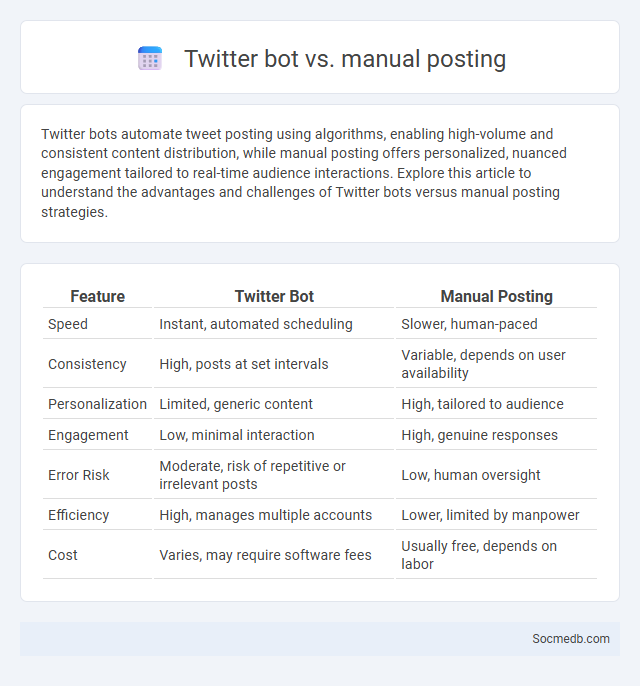
Photo illustration: Twitter Bot vs Manual Posting
Twitter bots automate tweet posting using algorithms, enabling high-volume and consistent content distribution, while manual posting offers personalized, nuanced engagement tailored to real-time audience interactions. Explore this article to understand the advantages and challenges of Twitter bots versus manual posting strategies.
Table of Comparison
| Feature | Twitter Bot | Manual Posting |
|---|---|---|
| Speed | Instant, automated scheduling | Slower, human-paced |
| Consistency | High, posts at set intervals | Variable, depends on user availability |
| Personalization | Limited, generic content | High, tailored to audience |
| Engagement | Low, minimal interaction | High, genuine responses |
| Error Risk | Moderate, risk of repetitive or irrelevant posts | Low, human oversight |
| Efficiency | High, manages multiple accounts | Lower, limited by manpower |
| Cost | Varies, may require software fees | Usually free, depends on labor |
Introduction to Twitter Automation and Manual Posting
Twitter automation streamlines content scheduling, engagement, and follower growth using tools like TweetDeck and Hootsuite, saving you valuable time while maintaining consistent activity. Manual posting offers authentic interaction by crafting personalized tweets, responding in real-time, and fostering genuine connections with your audience. Balancing automation with manual tweets optimizes your Twitter strategy for maximum reach and engagement.
What Is a Twitter Bot?
A Twitter bot is an automated software application designed to perform tasks on the Twitter platform, such as posting tweets, retweeting, liking content, or following accounts. These bots use predefined rules or artificial intelligence to interact with users, amplify messages, or gather data, often operating at speeds and volumes impossible for humans. While some Twitter bots enhance engagement and provide customer service, others may spread misinformation or spam, making bot detection crucial for maintaining platform integrity.
Manual Posting on Twitter: Overview
Manual posting on Twitter allows you to craft personalized tweets tailored to your audience's interests, ensuring authentic engagement. This approach gives you full control over timing, content, and interactions, fostering genuine connections with followers. By manually posting, you can quickly respond to trends and update your strategy based on real-time feedback from your Twitter community.
Key Differences Between Twitter Bots and Manual Posting
Twitter bots automate content posting using algorithms, enabling high-frequency and consistent messaging, while manual posting relies on human input for personalized and context-aware tweets. Bots efficiently handle repetitive tasks but may lack nuance, whereas manual posts provide authentic engagement tailored to Your audience's preferences. Understanding these key differences helps optimize social media strategies for both efficiency and genuine interaction.
Pros and Cons of Twitter Bots
Twitter bots automate content posting, engage with followers, and analyze trends, enhancing your social media strategy by saving time and increasing reach. However, they can also spread misinformation, reduce genuine interactions, and risk account suspension if used improperly. Understanding these pros and cons helps you leverage Twitter bots effectively while maintaining authentic engagement.
Advantages and Challenges of Manual Tweeting
Manual tweeting enables authentic engagement by allowing personalized responses and real-time interaction with followers, fostering stronger community connections. It ensures higher content quality through careful curation and strategic timing, enhancing brand credibility and user trust. However, manual tweeting demands significant time investment, risks inconsistent posting schedules, and may limit scalability in managing large social media accounts effectively.
Use Cases: When to Use Bots vs Manual Posting
Social media bots excel in scenarios requiring rapid responses, repetitive tasks, and 24/7 engagement, such as customer support, content distribution, and real-time monitoring. Manual posting is preferred for personalized content, creative storytelling, and nuanced audience interactions that demand a human touch and emotional intelligence. Balancing bot automation with manual input maximizes efficiency while maintaining authentic user engagement on platforms like Facebook, Twitter, Instagram, and LinkedIn.
Impact on Engagement and Reach
Social media platforms significantly enhance engagement by enabling real-time interaction and personalized content delivery, increasing user participation and brand loyalty. Algorithms prioritize relevant posts, extending reach and attracting diverse audiences beyond organic followers. Metrics such as likes, shares, comments, and impressions provide critical insights into audience behavior and content effectiveness.
Best Practices for Safe Automation
Implementing best practices for safe automation in social media includes setting strict access controls and using dedicated API keys to limit data exposure. Monitoring automated actions continuously helps prevent spammy behavior and ensures compliance with platform policies. Prioritizing transparent user notifications about automation builds trust and minimizes the risk of account suspension.
Conclusion: Choosing the Right Strategy for Twitter
Selecting the right strategy for Twitter hinges on understanding your target audience's behavior and preferences, leveraging analytics to optimize content timing and format. Tailoring your approach to emphasize engagement through multimedia posts, interactive polls, and timely responses will boost your brand's visibility and follower loyalty. Your consistent analysis and adaptation of these tactics can significantly enhance your social media impact on Twitter.
 socmedb.com
socmedb.com